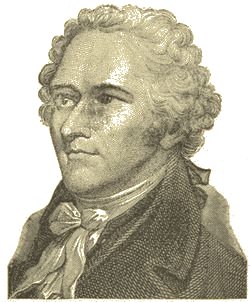Alexander Hamilton was one of the Founding Fathers of the United States and a prominent figure in American history. He made significant contributions to the formation of the new nation and played various roles in government and politics.
Background: Alexander Hamilton was born on January 11, 1755, or 1757 (the exact year is debated) in the West Indies (either Nevis or Saint Kitts) and later migrated to the American colonies. He arrived in New York City in the 1770s and became involved in the American Revolutionary movement.
 Accomplishments and Contributions:
Accomplishments and Contributions:
- Founding Father: Hamilton was one of the Founding Fathers of the United States, participating in the Continental Congress and signing the U.S. Constitution in 1787.
- Federalist Papers: Alongside James Madison and John Jay, Hamilton authored a series of essays known as the Federalist Papers. These essays provided a strong defense of the new U.S. Constitution and were instrumental in gaining support for its ratification.
- Secretary of the Treasury: In 1789, President George Washington appointed Hamilton as the first Secretary of the Treasury. In this role, Hamilton proposed and implemented a series of financial and economic policies that laid the foundation for the nation's economic system.
- Financial Plans: Hamilton's financial plans included the assumption of state debts, the creation of the First Bank of the United States, the establishment of a national currency, and the promotion of manufacturing and industry through protective tariffs. These measures helped stabilize the nation's finances and encouraged economic growth.
- Co-Founder of the U.S. Mint: Hamilton played a key role in establishing the U.S. Mint, which produced standardized coinage for the country.
- Military Service: During the American Revolutionary War, Hamilton served as a senior aide-de-camp to General George Washington. He played a crucial role in several battles and became known for his military leadership.
- Founder of the New York Post: In 1801, Hamilton founded the "New York Evening Post," which is now known as "The New York Post." The newspaper continues to exist today.
- Orphan Asylum Society: Hamilton co-founded the Orphan Asylum Society of New York, which aimed to provide care and education to orphaned and needy children.
- Death in a Duel: Tragically, Alexander Hamilton died in a duel with Aaron Burr, the Vice President of the United States, on July 11, 1804. He succumbed to his injuries a day later.
Alexander Hamilton's contributions to American government, finance, and economics had a profound and lasting impact on the nation. His vision for a strong federal government, a sound financial system, and a diversified economy helped shape the United States into a stable and economically powerful nation. His legacy continues to be celebrated and studied in American history and political science.
The result of Alexander Hamilton's financial plans was increased economic growth and stability in the United States. The nation's credit improved, foreign investment flowed in, industries expanded, and the federal government had the resources to function effectively. Hamilton's vision for a strong federal government with a robust economic foundation helped pave the way for the United States to become an economic powerhouse of capitalism in the years to come.
|
 Accomplishments and Contributions:
Accomplishments and Contributions:






